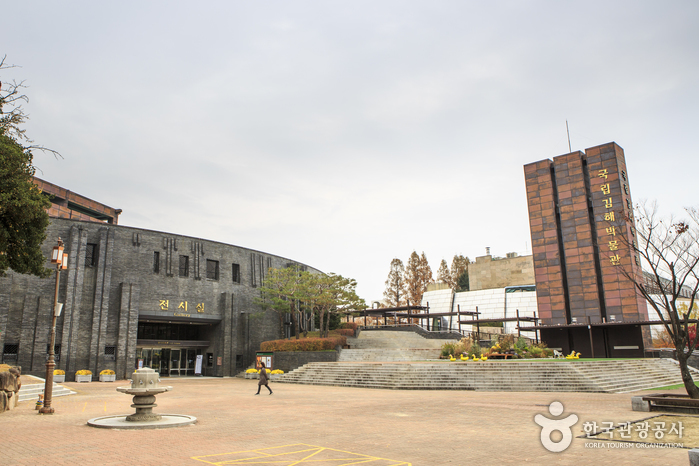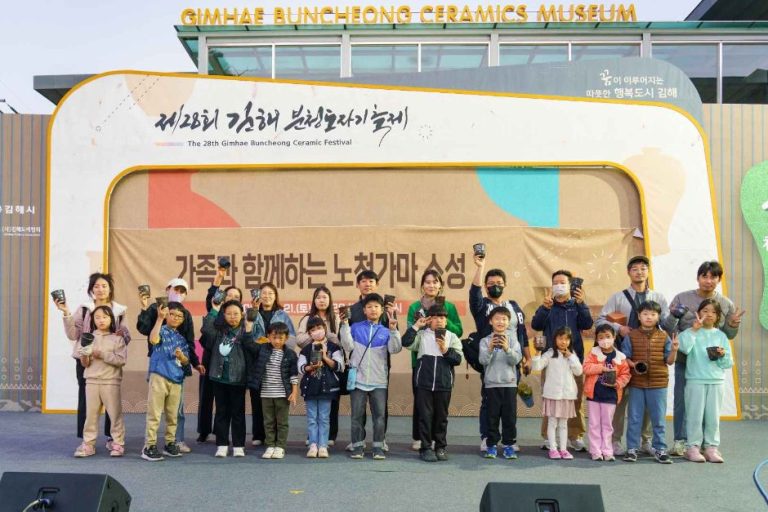The Painters: The Gaya Kingdom – Gimhae(페인터즈 가야왕국-김해)
The Painters: The Gaya Kingdom – Gimhae(페인터즈 가야왕국-김해)
– Address : 경상남도 김해시 가야테마길 161 (어방동) Cheolgwangsan Performance Hall at Gimhae Gaya History Park
※ Presentation Information
– Age Limit
All ages
– Location
Cheolgwangsan Performance Hall at Gimhae Gaya History Park, 161 Gaya thema-gil, Gimhae-si, Gyeongsangnam-do
– Event Duration
60minutes
– Sponsor
㈜펜타토닉
– Co-Sponsor Phone
02-766-7848
–
– Programs
“The Painters” is the iconic Korean nonverbal show that proved that improvisational drawing can be a performance. The show has become so popular that it has been performed in 133 cities in 19 countries around the world, reaching more than 1 million people a year. This new version of the show, “The Painters: The Gaya Kingdom,” integrates the story of the ancient Korean kingdom of Gaya with the existing repertoire for a unique performance.
In “The Painters,” the performers use a wide range of artistic techniques to fill the stage, including grattage, scratching, action painting, and marbling. Mystical scenes painted with UV fluorescent paints, as well as the fantastic marbling art created through water and light, are sure to capture the audience’s attention. A particularly memorable moment occurs when the audience is invited to join the painters on stage to complete a painting, often turning the performance venue into a sea of laughter.
“The Painters: The Gaya Kingdom” can be enjoyed by everyone regardless of language barriers. It is held at Gimhae Gaya History Park. After the performance, you can continue the experience by participating in a hands-on program where you can make bows, shields, pottery, and more at the theme park.
–
◎ Nearby Tourism Infobox
⊙ Gimhae Gaya History Park (김해가야테마파크)
View detailed guide on Korea Trip Guide →
– Homepage
https://gtp.ghct.or.kr
https://www.instagram.com/gayapark/
– Tel
+82-55-340-7900
Gimhae Gaya History Park is a resting area that provides comfortable relaxation in the daily lives of the busy people and also a cultural complex where you can experience various cultures with your family, lover and friends.
Interactive theme park combining Education + Entertainment Edutainment park where you can see, hear, touch and learn about the history of Gaya and the brilliant heritage of its people through plays, experiences and exhibits.
⊙ Gimhae Astronomical Observatory (김해천문대)
View detailed guide on Korea Trip Guide →
– Homepage
www.ghast.or.kr (Korean only)
– Tel
+82-55-337-3785
Gimhae Astronomical Observatory opened on February 1, 2002 as part of the Millennium Commemorative Project that started in December 1998. It was built to satisfy the general public’s curiosity about the universe and celestial bodies, inspire young people, and give everyone a unique, memorable experience. The observatory is shaped like an egg, in memory of the legend of King Kim Suro, the founder of the Garak Kingdom, according to which the king was born from an egg.
It is said that the queen of King Suro, Heo Hwang-ok, was a princess from the Indian country of Ayuta. Since sophisticated navigation equipment had yet to be invented, it can be assumed that she found her way to the Garak Kingdom by following the stars. It is also said that a prince of the Garak Kingdom built an observatory on the highest point of a mud fortress in Jinrye in order to make astronomical observations. The place is still referred to as Bibidan, which means a place to watch the stars.
These historical facts indicate the stars were very important to the Gaya, an ancient kingdom established mainly in the Gimhae area. The peak of Bunseongsan Mountain, where the observatory is located, offers sweeping views of the entire area of Gimhae. The night sky of Gimhae offers a breathtaking sight.
⊙ Bunsanseong Fortress (김해 분산성)
View detailed guide on Korea Trip Guide →
– Homepage
tour.gimhae.go.kr
www.cha.go.kr
– Tel
+82-55-330-3925
Bunsanseong Fortress was constructed in the 3rd year of the reign of Goryeo’s King U (1377) by Magistrate Park Wi to defend against foreign enemies, but it was destroyed during the Japanese invasion of 1592. The fortress we see today was reconstructed by Magistrate Jeong Hyeon-seok in the 8th year of the reign of Joseon’s King Gojong (1871). However, it is estimated that it was first built during the days of Gaya. It is a temoe-style fortress with rocks piled up like a long band at the peak of Bunsan from which downtown Gimhae, Gimhae Plains, the Nakdonggang River and the South Sea are all in a single, panoramic view. Today, fortress walls remain stretching for some 900 meters on the slope towards the city and, inside the fortress, there are two gate sites in the south and north, an auxiliary gate on the west, a well site and several other building sites. The exact length of the remaining fortress walls is 929 meters and the average x_width is about 8 meters.
Inside the fortress lies Haeeunsa Temple, which was built to pay respects to Queen Heo of Garak who had come from the sea, according to stories. The temple also enshrines portraits of King Suro and Queen Heo that were painted during the Joseon dynasty. During the Japanese invasion of 1592, monk soldiers were stationed at this temple.
The fortress is more popularly called “Manjangdae” by Gimhae locals, and this name originated from the description, “A tall tower 10,000 (man) gil in x_height,” granted by Daewongun in the Joseon dynasty for this advanced base that defeats Japanese invaders. A writing of “Manjangdae” written by Daewongun himself as well as his stamp are engraved on a rock behind a beacon that was restored in 1999.
⊙ Olive Young – Inje Univ. Branch [Tax Refund Shop] (올리브영 인제대)
–
⊙ Gimhae National Museum (국립김해박물관)
View detailed guide on Korea Trip Guide →

– Homepage
gimhae.museum.go.kr
The Gimhae National Museum was opened on July 29, 1998, in order to research and preserve the cultural heritage of the ancient kingdom of Gaya. The museum is at the foot of Gujibong Peak in Gimhae-si, the spot where the kingdom is believed to have been founded. The museum exhibits the cultural assets of Gaya, as well as cultural relics from the prehistoric age in the Busan and Gyeongsangnam-do areas, and the cultural heritage of Byeonhan, which was the foundation for the growth of Gaya.
The exterior of the museum is made using black bricks representing iron ore and charcoal famous during the Gaya Kingdom. There are two exhibition halls, while the walkway to the halls have approximately 1,300 artifacts in display.
⊙ Dongsang Market (동상시장)
– Homepage
www.ds-market.co.kr
Formed in 1945, Dongsang Market is a lifestyle-centric traditional market that offers a slew of daily necessities like vegetables, fruits, rice cakes, fishery products, and side dishes, as well as a popular alley specializing in Kalguksu (noodle soup). Designated as a cultural tourism market in 2017, it has since evolved into a vibrant space where traditional Korean culture harmoniously coexists with diverse global cultures. As more foreign workers have begun frequenting the market in recent years, a number of Asian grocery stalls have opened. In particular, vegetables favored by Southeast Asian customers, ritual foods, and Kalguksu (noodle soup) have become local specialties.

![Uniqlo – D-CUBE Geoje Branch [Tax Refund Shop] (유니클로 디큐브거제)](https://ktrip.blogsailing.com/wp-content/uploads/2025/11/2888451_image2_1-768x576.jpg)
![Soda – Lotte Gimhae Branch [Tax Refund Shop] (소다 롯데김해점)](https://ktrip.blogsailing.com/wp-content/uploads/2025/11/2885967_image2_1-768x576.jpg)
![Jigott – Lotte Gimhae Branch [Tax Refund Shop] (지고트 롯데김해)](https://ktrip.blogsailing.com/wp-content/uploads/2025/11/2886134_image2_1-768x576.jpg)
![E-Mart – Yangsan Branch [Tax Refund Shop] (이마트 양산)](https://ktrip.blogsailing.com/wp-content/uploads/2025/11/2888468_image2_1.jpg)